|
|
| The Wire, just below Silver's pool |
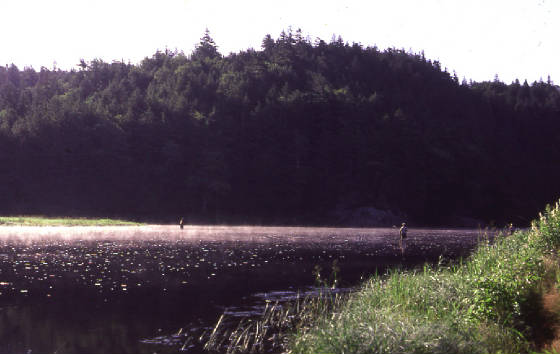
|
| The Wire - excellent dry fly water |
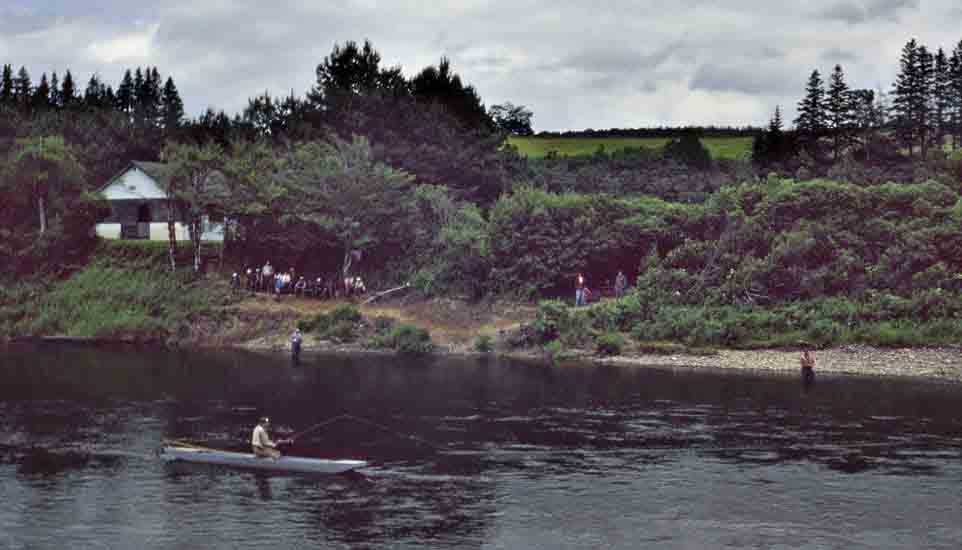
|
| St Mary's Ford Pool 1960s - Photo by Paul Marriner |
HISTORY OF THE ST. MARY'S RIVERby Jack Anderson
Ladies and gentlemen, I think this is supposed to be a little talk on history. History, as I known it, to be a little
bit interesting, contains a certain amount of facts, fiction, reminiscences and mostly nostalgia. I have not done a great
deal of research, so if I make slight errors, you can correct me afterwards, please.
This River, the St. Mary's,
was named after the old French fort, Forte St. Marie, which was built by the French in 1654, at the lower end of Sherbrooke
Village. The fort was built, ostensibly, to protect the French fishermen and fur trade that was along the coast, but in my
opinion, it was built mostly as a means of protecting the French people who wanted to come in and get their winter's supply
of fish. One of the first things the French did when they built this fort was to try to teach the Indians more and better
ways of catching or taking salmon. This apparently they did. However, the French didn't remain in Forte St. Marie very
long. I think it was five years and the British came and chased them out, and, as far as I know, the River has been predominately
held and settled by British people since that date. That would be about 1669, when the British took over. In fact, some years
later, one of the British regiments spent a winter down river, between Sherbrooke and Sonora, in tents. Hence, some of the
older people still refer to that section of the St. Mary's River as Canvastown because of the British regiment that spent
the winter there.
Contrary to popular thought, the original settlers along the River did not mostly come by water.
They came overland from Pictou County and followed down both courses of the river, the East river and the West river, each
generation moving successively a little bit further down the river, till eventually they settled the Sherbrooke area. Most
of them, as I say, came overland from Pictou County rather than by water.
Here is a bit of description of the
River. Above the tide, the river flows ten miles roughly north to Melrose where it branches into the east and west branches,
and through its many tributaries to its place of origin. And the place of origin of our river, I believe, is in five separate
counties, namely Guysborough, Antigonish, Pictou, and even parts of Hants and Halifax Counties. So, for any fishermen who
have waded at the Ford, just think that some of that water has come a long way before it gets in your socks.
At
one time, the river carried a fair portion of the commerce of Nova Scotia. Beautiful, two and three and even four masted sailing
ships, carrying cargoes of lumber, mostly to the West Indies and the eastern seaboard of the United States, returning with
cargoes of coal, salt, molasses, and odd bit of rum. Some ships were built at Sherbrooke, Sonora, and at St. Mary's River,
and they eventually found their way all over the world, and made their contribution to the making of this country.
Around 1930, sail gave way to steam and the long lumber gave way to pulp wood, and the ships that began to come in for the
pulp cargoes were mostly of Norwegian registry and pulpwood was shipped down the river, mostly to the eastern seaboard of
the United States and to Europe. Some of these ships had quite a precarious job getting up and down a narrow crooked channel,
and I can remember my grandfather telling me that sometimes these ships would go over the bar at Sonora with one inch to spare
between the keel and the sand. They would wait for the swell to rise and then they would try to ride out over the top of the
swell.
So, as I say, the long lumber has given way to pulp wood and sail has given way to the steam ships. One
thing I would like to point out to you is that the old method of cutting the logs and the pulp wood, was mostly by cutting
and piling the log in the woods or in brows along the river; cut and then hauled by horse and sleigh in the winter time, and
piled along the banks to wait the ice going out in the Spring. This has always been a bone of contention between myself and
some other members of the family but there is an awful lot to be said for the old method of hauling out the logs and the pulp
wood. Roads were cut for double teams, stumps were cut down, the wood was hauled on frozen ground, and there was no such things
as the tree farmer ruts and all the ripping and tearing that�s being done today.
So there's something
to be said for the old methods. After the ice went out in the Spring, the logs and pulpwood were driven down the river and
I can still see some of these old log drivers, around the bridge in Sherbrooke, mostly in March, sometimes in April, wading
up to their hips, or even further, and doing this all day, sleeping mostly in bunkhouses in their wet underwear and with their
socks still on, and they never seemed too many colds or have too many cases of pneumonia.
So, ladies and gentlemen,
I think there's something to be said in favor of Stanfields long wool underwear and APH (Acadia Pride Homespun) pants.
It was quite a thing to see some of these old log drivers coming down on the big, big logs. I can remember, in my time, two
in particular who were really expert on the logs and there are still some of their families left along the river valley. One
was Freeman Smith; an excellent man on logs. However, I still don't think they were as good as the present day log rollers
who do exhibitions all over the country. Pulp drivers usually tried to get on a big crooked hemlock that didn't roll too
much.
After the logs got out to Sherbrooke, there were two or three or several mills at one time, mostly run by
steam, or all run by steam. They had hard working crews, inveterate tobacco-chewers because they couldn't smoke in the
mills, and they worked long days at hard work, with no coffee breaks, no union and low pay, but still seemed to enjoy life,
make a living, and bring up a family.
One other thing I would like to point out to the salmon anglers about those
days of the big log drives, is that the pools where you now fish become choked with weeds and grass late in the summer. We
didn't have too much of that however, when the logs were coming down the river. The big logs would father up big chunks
of weeds and grass along the river, and almost always, down around Sherbrooke, you'd see the odd big hemlock log coming
by with a chunk of sod on it as big as a table. Once the log drives stopped, then the weeds began to grow up in the Ford pool,
and the Crow's nest, and all such places.
When the log drives were on, we didn't have any of that. So,
although an awful lot of anglers complained about losing fish by going around pulpwood stick or under a log jam, they still
kept the river cleaned out and, in my opinion, a lot better than it is today.
Don't think that environmental
control and conservation of salmon in this particular area, which may be one of our ultimate aims, is anything really new.
In this district, prior to it becoming a municipality, the top man was the Squire and he had his appointees who carried out
various duties. Thus, around the year 1870, just prior to the Municipality of St. Mary's being formed, the Squire and
his henchmen passed a resolution prohibiting the spearing of salmon on Thursday. This was their means of conservation, that
one day per week they could not spear. Well, at least that was a start.
Around the early 1900's, maybe even
prior to that, some of what I shall refer to as the old time or well-known anglers, started coming to the St. Mary's River
for the salmon fishing from all over Nova Scotia and New Brunswick and some parts of England. At that time, when they first
started coming here, tourists, or I may as well say salmon fishermen, would have to be really dedicated to get on a slow train
in Halifax and sit on that for maybe half a day to Antigonish.
They would then get off the train there, at Lord
knows what time of night, hire a horse and buggy and drive to Sherbrooke or Melrose or Waternish someplace like that to go
fishing. These fellows were real tourists. How many of the people that you see on bus tours driving around the country, would
entertain the thought of drivign 50 miles by horse and buggy to spend their vacation? Those fellows did. These fellows were,
in my opinion, the first tourists that we had in this community, and I will say they may be the best tourists that we have
in this area as far as making contributions to local economy.
I have a great number of names of those tourists
that I refer to as the old time sports fishermen who came to Sherbrooke and I don't think there's anything wrong with
me listing off a few of them. These people, to the best of my knowledge, had only two or three places to stay. One would be
at the old Silver Inn in Sherbrooke and another would be the Crow's Nest, or as we refer to it, the Coffee House, which
was on the far side of the river opposite the Bells of St. Mary's. Some of these old gentlemen who came down here at that
time, shortly after the turn of the century, included Dr. Silver, who was Dr. Gordon Silver's father; Mr. Barnes; Mr.
Rice; Mr. T.S. Patillo, whose company is still in business in Truro; Mr. MacLeod; Mr. MacKay; Mr. Jimmy Eastwood; Mr. Critchley
who had a place up at the Stillwater Bridge and whose wife, I believe, was the daughter of Sir Sanford Fleming who built the
Canadian Pacific railroad. We also had English nobility living here on the bank of the river, Sir Gordon and Lady Lee, and
these are just a few of the names but they were the start, I think, of what we call the present day tourist business. One
of the names omitted, on purpose in fact, was a gentleman who had considerable money back in the twenties and who, with some
others formed a club and built a place on the river. They furnished the place, spent a lot of money here and stayed here quite
some time until the crash of 1929 which made a bit of a bust. This was during the days of prohibition and one thing that the
truckers marvelled at when they hauled all the furniture from the railroad station to the clubhouse on the St. Mary's
was the fact that they had so much furniture for one clubhouse and, another thing the truckers couldn't understand was
why they had so many pianos crated. As I say, this was during prohibition, and I don�t think there were ever that many
pianos in this particular place.
Now, for the old-time guides; I mention a few names but this is not complete
in any way, shape or form. There was Blair Archibald in Stillwater here; Charlie Pye of Sherbrooke; Henry MacLean and his
sons of Stillwater; Bill MacIntosh and a large family, all excellent guides; Tim McGrath; Walter Smith; and many others. We
even had, as I mentioned before, some very notable people come and fish along the river and one of the greatest sports celebrities
from the United States spent some time here and I am referring, in this particular case to the great Babe Ruth. His first
trip here, I think, introduced him to what the older people remember as McKenna's Pictou Twist chewing tobacco for which
he acquired a taste. Babe Ruth's career might have been considerably shortened had not one of our local guides, Dan MacIntosh,
pulled him out of the Stewart Pool down here, early in May just as he was going by the end of the boat. I think Babe himself
would never have made it. But anyway, he was taken back into the boat, had his stay here and went home with a goodly number
of salmon and I don't think any of them caught by himself.
So, this ends my short presentation, ladies and
gentlemen, but in closing, I have a little quotation from an elderly Scottish gentleman who used to fish on the river. He
was the only fisherman I ever knew who had enough intestinal fortitude to go fishing salmon, in the summer, in May and June,
wearing a kilt. He did just that, and we complain about the black flies on the river! So, I quote, just as he said to me shortly
before he died, "If I never take another salmon, I am satisfied. The river has been good to me."
Thankyou,
Jack Anderson
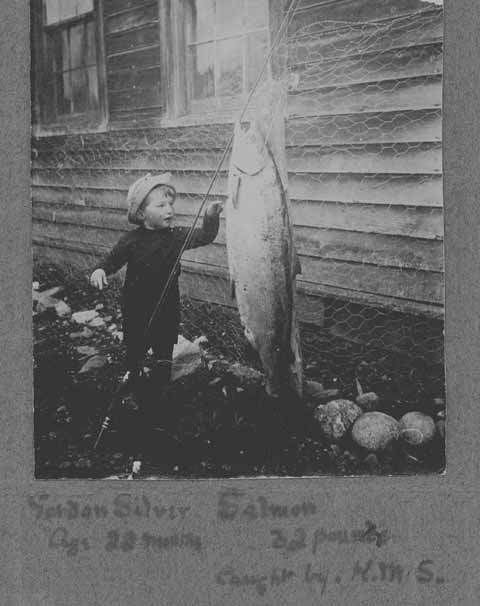
|
| 22 month old Dr. Gordon L Silver admires a 32 lb St. Mary's salmon |
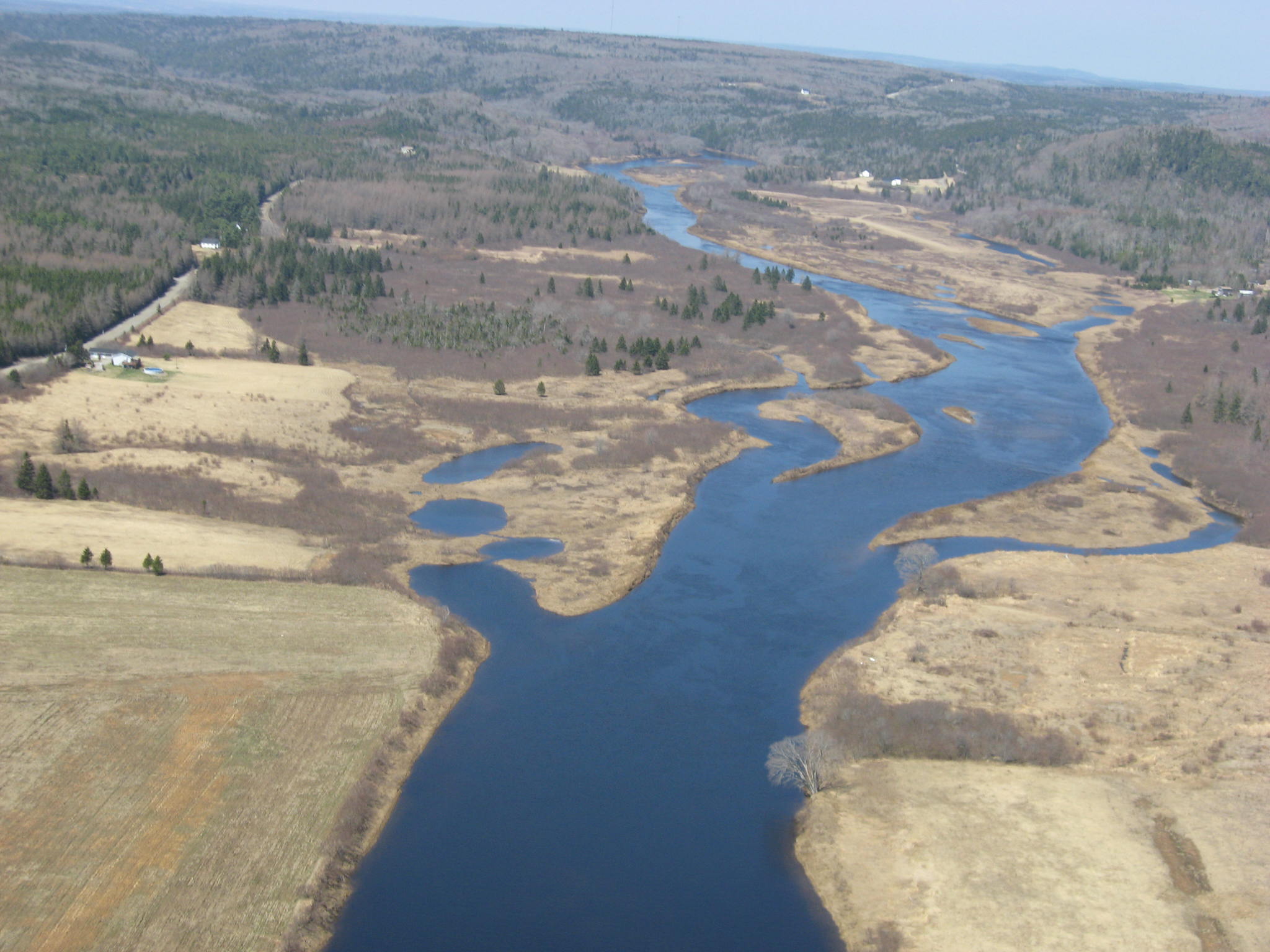
|
| Birds eye view of Frasers Gully, Hen Island, Lyons Pool, & Graveyard Pool - Dennis Baker, 2009 |
St. Mary's River Guides - The MacIntosh Family
St. Mary's River Guides - The Weir Family
St. Mary's Riverboat - The Tom Ross Punt
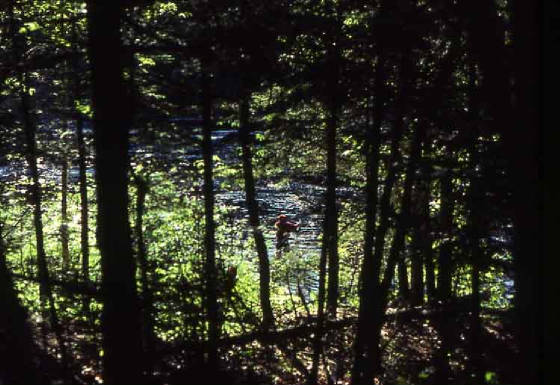
|
| An angler fishes Silver's Pool from the ledge |
|

